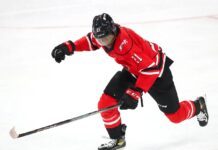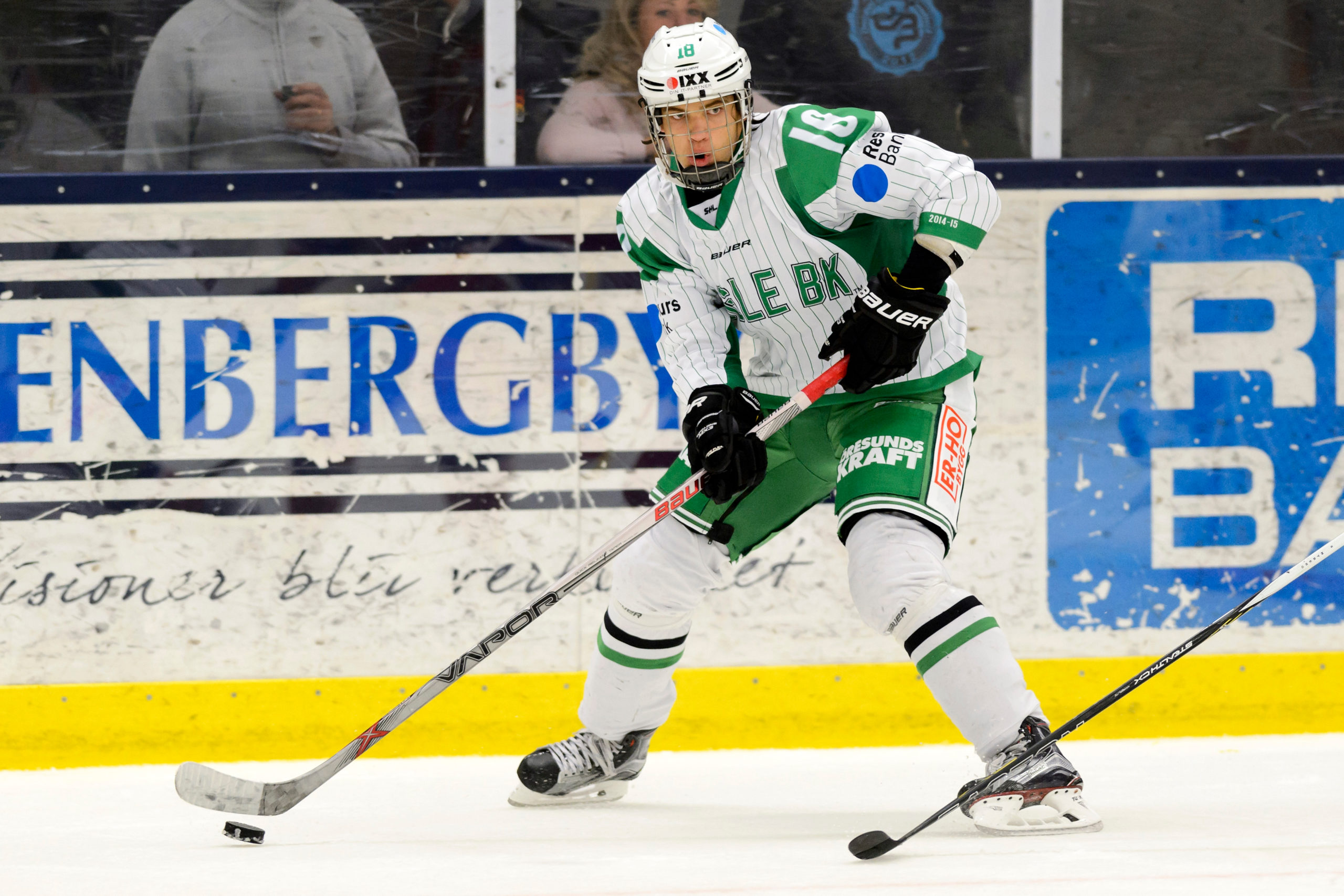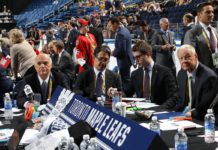With the 17th overall draft selection in the 2017 NHL Draft, the Toronto Maple Leafs have selected right-shot defenceman Timothy Liljegren.
Originally considered a surefire top-three pick early in the season — there were “tank for Liljegren” jokes as recently as last September after his exceptional draft-1 season — the 6’0, 192-pound Swede owns a potential top-pair defenceman’s skill set. However, his 2016-17 season was beset by mono (understandably, a major inhibitor for prospects in their draft years) and he struggled upon return, failing to make the cut for Team Sweden’s World Junior team. Later in the season, he was loaned out to Timrå IK of the Allsvenskan (the Swedish second division) in search of more ice time.
A product of the Rogle BK junior system, Liljegren has also been labelled a one-way defenceman by his critics with some question marks surrounding his hockey sense. However, he has good defensive instincts that can be honed, and many of those issues could be attributable to, or at least exacerbated by, the effects of mono and bouncing between so many different teams in his draft year.
There were also some rumblings about Liljegren leaving a less than great impression in his combine interviews, which is addressed here by Mark Hunter, who describes him as an introverted kid who is pretty honest about the faults in his game.
When at the top of his game, Liljegren — a fantastic skater over all ranges — is an adept problem solver in his own end and an excellent puck mover. Thanks to his elusiveness and stickhandling ability, he’s able to beat players one-on-one. He owns a big one-timer on the power play and a hard, accurate wrist shot that can solve goalies from far out. When it comes to Liljegren’s offensive skill set, the toolbox is so full it’s overflowing.
While there is no sure thing at pick #17 in the draft, the Leafs just made a significant addition at a position of major need (defence, specifically the right side) in their system and selected a player with the type of upside that could’ve placed him much higher in the draft order if not for some extenuating circumstances — a case of ‘Best Player Available’ meshing perfectly with positional need.
He’s a talented young man, and when he fell that far, it was a no-brainer. He had mono for eight weeks. He was out for a long period of time. Anybody who had mono knows how much it takes out of your body. When he got back going again, it took some time. He’s an elite talent, an elite skater, and he can move pucks. Toronto Maple Leaf fans will really enjoy him.
– Mark Hunter, Director of Player Personnel
Liljegren told TSN Overdrive after the pick that he intends on spending one more year in Sweden developing — hopefully with a healthy, full season on a consistent team — before he plans on making the jump to North America.
Timothy Liljegren Scouting Report
Courtesy of the 2017 NHL Draft Blackbook:
Timothy Liljegren is a Swedish offensive defenseman who played both in the SHL for Rogle and Rogle’s junior affiliate in the 2016-17 season. Liljegren appeared in the 2016 Ivan Hlinka Tournament, recording 4 points in 5 games and the 2017 World U18 Championships posting 2 assists in 7 tournament games. Liljegren’s physical skills are impressive. He has an explosive stride, and generates speed out of his turns because of his strong cross-overs. His edgework is exceptional and he can turn tight and quick, with his head and upper body leading his body. He makes transitioning and changing directions look extremely easy. When skating backwards, he generates easy power through cross-overs and this makes for terrific recovery ability when faced with outside speed.
His stride is very effective when carrying the puck. He is strong on his skates and takes very few strides to get up the ice. Although he is only listed at 6’0” he looks and plays bigger. On his rushes, he gets by because of his powerful legs and long reach. He has nice hands, and is tough to defend one-on-one. He can deke defenseman with a quick move at speed and drive them wide, proving to be dangerous in open space. Once in this space, he is effective, but often he tries too hard as an individual to create these rushes. His ability to determine whether or not to rush the puck needs to be refined.
Timothy can score from anywhere in the offensive end, via a one-timer or flat footed wrist shot. His shot is extremely hard and makes every shot a tough save. He has the ability to pick corners because his head is constantly up and looking at the net while shooting the puck. He also has shown scoring instincts around the net, and is dangerous when he is in close quarters. His ability to glide on his inside and outside edges give him extra time when in close with the goaltender. This skating skill gives him the opportunity to be patient when gliding wide around defenseman or goaltenders as he does not have to settle for a bad angle shot.
Although Liljegren has solid offensive skills, his defensive and neutral zone play needs work. It appears when under pressure, especially in defensive corners, he does not know when to move the puck. He can lack urgency in his game and he can hold onto the puck for far too long. It is not often that you see him make a simple breakout pass or a chip off the glass when he has no open passing lanes. He extends plays in attempt to manufacture a stretch pass or deke a defender. There are times when he does succeed and he ends up sending a teammate on a breakaway or going on a rush, but each successful play comes with a fair share of turnovers. He possesses the vision and skating ability to be a consistent puck-moving defenceman, but he did not show enough confidence in his teammates, especially in international play.
Despite showing some defensive zone weaknesses, Liljegren did show the ability to identify open teammates and could be a playmaker when he wanted to. He is comfortable at his own blueline on regroups, when his team is transitioning back up ice. He can see the ice well from this position and use his explosive feet to buy him time. When Liljegren is in the offensive end or on the power play, he can make plays and is less likely to play selfishly. Most of his turnovers result from trying to skate pucks out of the defensive zone.
Timothy Liljegren is a talented offensive prospect. That talent alone warrants a selection an early first round pick in the 2017 NHL Draft.
Timothy Liljegren Video
Timothy Liljegren Statistics
| SEASON | TEAM | LEAGUE | GP | G | A | TP | PIM | +/- |
|---|---|---|---|---|---|---|---|---|
| 2012-13 | Kristianstad/Osby J18 | J18 Div.1 | 4 | 0 | 3 | 3 | 4 | |
| Kristianstad/Osby J20 | J20 Div.1 | 16 | 1 | 3 | 4 | 2 | ||
| 2013-14 | Rgle BK U16 A | U16 Elit | 27 | 22 | 19 | 41 | 24 | |
| Rgle BK U16 A | U16 SM | 3 | 2 | 2 | 4 | 0 | ||
| 2014-15 | Rgle BK U16 | U16 Elit | 8 | 9 | 7 | 16 | 4 | |
| Rgle BK J18 | J18 Elit | 14 | 4 | 7 | 11 | 2 | 11 | |
| Rgle BK J18 | J18 Allsvenskan | 14 | 3 | 6 | 9 | 6 | 2 | |
| Sweden U16 (all) | International-Jr | 9 | 3 | 3 | 6 | 0 | 3 | |
| 2015-16 | Rgle BK J18 | J18 Elit | 1 | 0 | 0 | 0 | 0 | 1 |
| Rgle BK J18 | J18 Allsvenskan | 1 | 0 | 0 | 0 | 0 | 0 | |
| Rgle BK J20 | SuperElit | 29 | 7 | 15 | 22 | 26 | 22 | |
| Rgle BK | SHL | 19 | 1 | 4 | 5 | 4 | -7 | |
| Sweden U17 | WHC-17 | 6 | 3 | 2 | 5 | 6 | ||
| Sweden U17 (all) | International-Jr | 7 | 4 | 3 | 7 | 6 | 0 | |
| Sweden U18 | WJC-18 | 7 | 1 | 5 | 6 | 0 | 0 | |
| Sweden U18 (all) | International-Jr | 12 | 1 | 6 | 7 | 2 | 2 | |
| 2016-17 | Rgle BK J18 | J18 Allsvenskan | 0 | 0 | 0 | 0 | 0 | |
| Rgle BK J20 | SuperElit | 12 | 5 | 2 | 7 | 8 | -7 | |
| Rgle BK | SHL | 19 | 1 | 4 | 5 | 4 | -3 | |
| Timr IK Loan | Allsvenskan | 5 | 0 | 1 | 1 | 4 | -2 | |
| Sweden U18 A | WJC-18 | 7 | 0 | 2 | 2 | 4 | -5 | |
| Sweden U18 (all) | International-Jr | 17 | 1 | 9 | 10 | 8 | -7 | |
| 2017-18 | Rgle BK J20 | SuperElit | - | - | - | - | - | |
| Rgle BK | SHL | - | - | - | - | - |




































